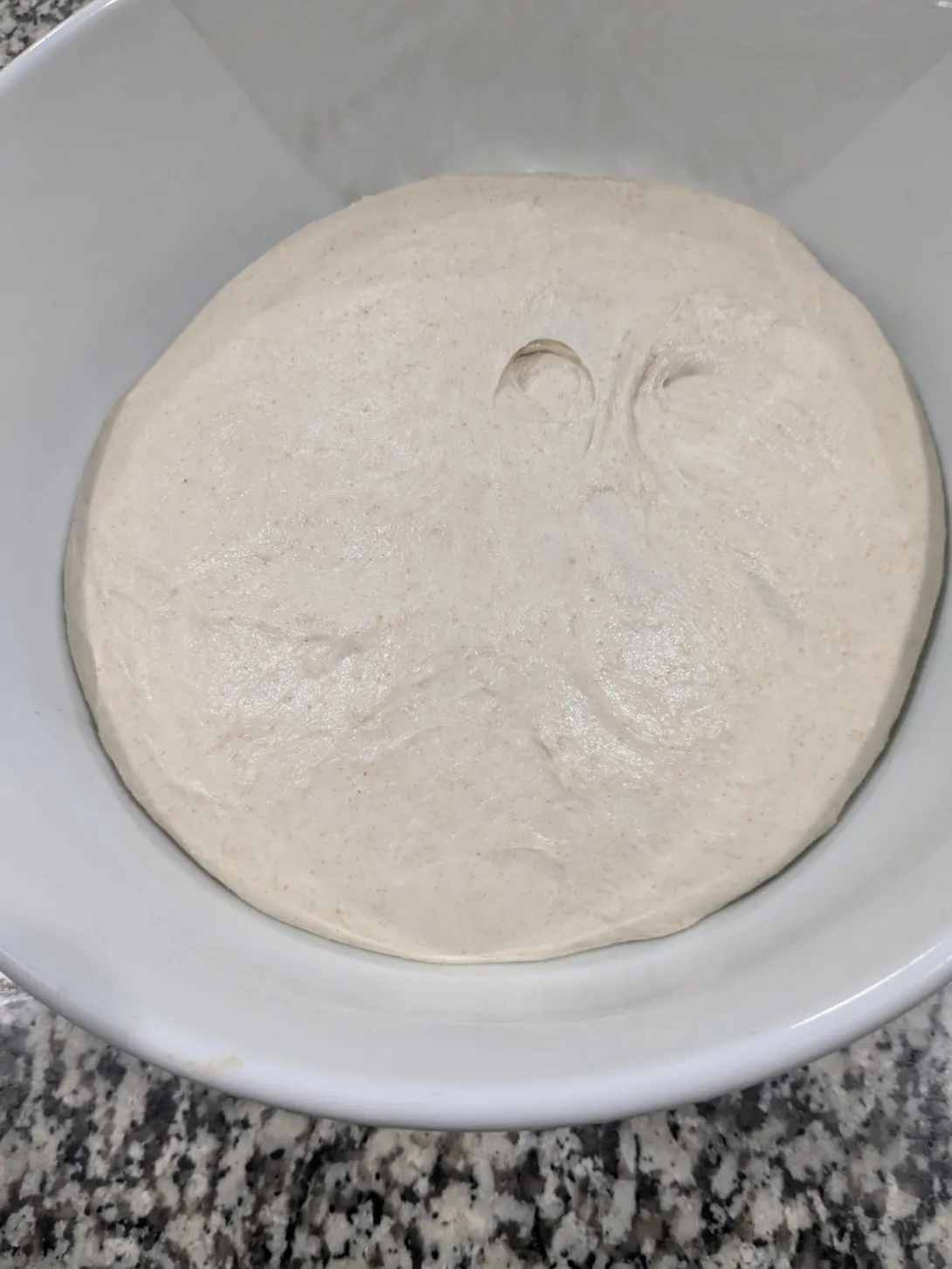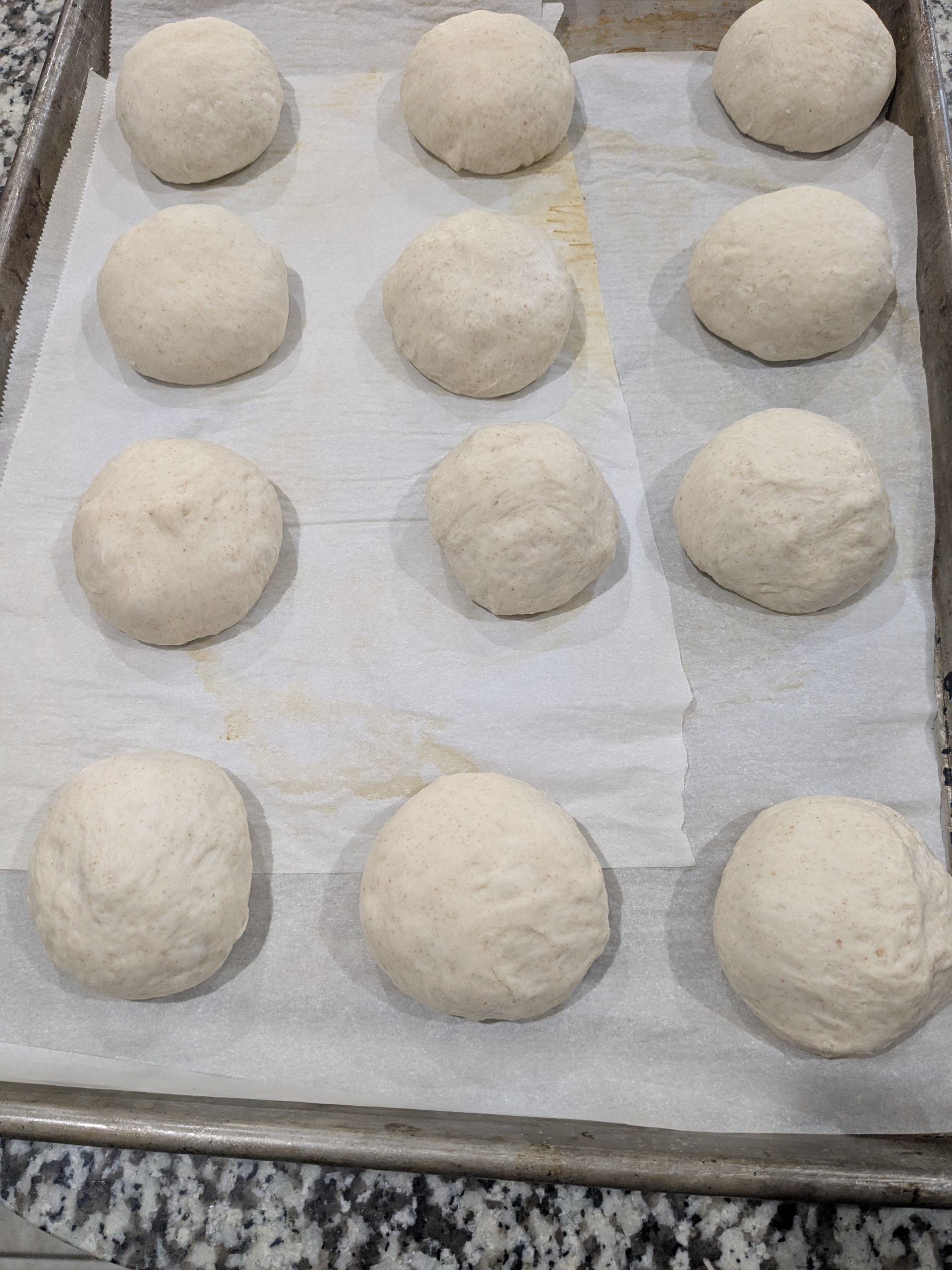
Observations
Refrigerating the at peak liquid levian had no adverse effects. After bringing it back to room temperature it was ready to go.
I have to say the low hydration, lightly enriched dough is really nice. Easy to handle and silky smooth.
Here we are a few minutes to go in bulk fermentation. The next step is dividing, shaping, and then into cool proof. More to come tomorrow.

Few things
The " Made in" carbon steel griddle said it was pre seasoned.
I resesoned it. Avocado oil very thin layer. 400° F for 25 minutes. I may reapply after it cools.
2. The temperature gun confirmed hot spots on the griddle. I will have to keep awareness high
3. The proofed muffins are very difficult to handle without degassing. Practice.
Going forward I see no benefits in buying packaged English muffins. For next weekend a double batch to send home with these two.
Satisfaction of making homemade ✅👍
Home made English muffins are so good. Yours look very tasty with those crisped edges. They are very tolerant to dough and fermentation variations, too. Here's one with 15% buckwheat and a little nigella seed -
TomP
Any tips for the griddle phase?
I think a moderate griddle temperature works best, 325 - 350 deg F as measured with an IR thermometer. I cook them on a dry griddle though some people like clarified butter. I always had trouble getting them cooked enough in the middle so I finish up with 5 minutes in an oven at 250 - 300 deg F. This is much easier and more tolerant than trying to balance out cooking the insides without overcooking the outsides.
Oh, and I like them a little smaller than many so I scale them to 80 - 85g each (I like my bagels smaller, too; most bagels these days are way too big IMHO).
Mine are also 80 g. I will try on a dry griddle. I was shooting for 350 on the IR. I am noticing it's not easy to get a consistent temp all over the griddle. I think dry may work better
The steel is well seasoned now. Thank you.
Yes, and my griddle usually keeps getting hotter from one batch to the next. I have to allow for that and keep turning the setting lower.
I actually have a very old Teflon griddle that I perfected making pancakes on, after burning quite a few. The thing is I want to move away from the Teflon. Especially this old pan, that is likely from before safety regulations were
Put in place.
Here's the griddle I use these days -
https://usa-shop.wekigai.eu/collections/frontpage/products/panache-griddle-pan
It will cook three at a time. The finish is baked vitreous material, not teflon. I sometimes also use a carbon steel skillet. I think both work as well as a cast iron skillet and are lighter. Either way, as long as I have used enough corn meal, semolina, etc., when I put them to proof, sticking hasn't been a problem.
I was thinking I need to use more semolina to keep the well proofed muffins from stick to the parchment during cool retard.
The photo below is of
Next is a simple relatively inexpensive aluminum sheet pan, that I seasoned. The well seasoned pan is my defecated nine slice Brooklyn Sicilian pizza pan. The 16 X 16 size is no longer available. The Brooklyn company that made them out of heavy black steel did not survive COVID. Being a sucker for nostalgia enter my substitution for a 9 slice pie
for English muffins. I bought rings and tried 2 different formulas but they weren't a success at all.They never got close to cooking inside even when I baked them to finish after the griddle. It looks like they can be shaped basically like hamburger buns but flatter so not nearly as wet as the ones I tried.
Any info appreciated . c
From my notes from June of last year (you will get a kick out of the first part):
I don't use muffin rings. I have a set but they always seem like too much mess and trouble. I use a lower hydration so the muffins will hold their shape on their own.
You don't have to press them but I find it makes for a more regular shape than just patting a ball of dough and takes less skill than rolling out a circle. I cut a gallon ziplock bag down the sides and open it up.Sprinkle with flour or corn meal. I put a dough ball on the bottom half, close the top half, and press down with a Pyrex pie plate until the form is larger than you want (it will spring back because of the gluten, of course). Rock the plate around to keep the shape circular. As the gluten relaxes and the pieces rise, they will get larger again.
Doing them again today, I would use a lower griddle temperature and a longer time per side.
🤣🤣🤣🤣 ok I’ll save this and try when I get back. No buckwheat but I’ll sub something. Thank you… 🙏
I'm pretty sure that we still have a tortilla press. Maybe that could be used for shaping the EMs, much like your pie plate method.
Paul
I would have used a press if I had one, but the glass pie plate is a good substitute for making English muffins. It needs to have a flat bottom for best results. With a press, you probably don't need to press it as thin as for a tortilla (and the dough will spring back, anyway).
Maurizio's method calls for a near collapse proof. While this does make them tricky to transfer to the griddle, it negates as my need for further shaping after balling. The ones I was able to transfer without damage naturally self shaped. Tom, next bake I will foll w your suggestion of much more #1 semolina in the proofing sheet pan.
If there's enough semolina or corn meal, I find I can tease up an edge of a muffin with my fingertips. From there I can get a spatula under it and transfer to the griddle, or even work it onto my hand and transfer it that way, depending of course on the consistency of the dough.
I shape and rest the muffins on small pieces of parchment paper, then pick up the paper and put it in the frying pan. Shortly thereafter the paper can be slid out from underneath the muffin.
Very simple yet ingenious solution! Thanks for chiming in!
I keep thinking about doing this but was never sure if the parchment would really release.
Heavy Semolina on separate squares.
I don't put anything on the parchment and haven't had a problem with sticking. Once the bottom cooks a bit, the paper will come away--much like in the oven where nothing seems to stick to parchment paper. I put bagels into boiling water the same way and pull the paper out with tongs. Of course, you might want semolina or cornmeal on the muffins for reasons other than stick-prevention.
Whoa! Better change my subject line from "I don't put anything on..."
I tried my first attempt at English muffins about a month ago. Why didn't I try it sooner??? They're easy to make and really good. You can make them out of any dough and they keep well. I just ate the last one from a batch I made Thursday. I'll make another batch tomorrow. I think I've got the routine worked out now so they always turn out the same. i'm using a large electric fry pan to bake/cook them. I put the lid on while "frying" the second side, and that seems to eliminate the need to bake them after "frying". Jim
That being said I am going to have to perfect the process with the stovetop griddle. Thanks for your help.
That is my breakfast on a workday, I have been buying store bought for years at close to $4:00 for 6 muffins. Yes I am going to start making my own.
After you make them successfully, those store ones will seem like cardboard.
I’ve not eaten a store English muffin in years lol! I gave them up. Have done without. We shall see.
I have bags of homemade English Muffins in my freezer. I pop them in the microwave for 30 seconds and then split them and toast. Works well.
I cut my muffin dough from a large rectangle with a cookie cutter and rest on parchment with semolina. I also started putting a cookie sheet over the muffins after I flip them to keep them flatter, I like them better that way. No fancy equipment, and you don't need a lot of weight, it just keeps them from dome-ing up and being more like a bun.
Even if there is a dome, it flattens out when the muffins are turned on the griddle. I press them out mostly to make them the diameter I want.
Thanks,
CF, Tom.
For the 411.